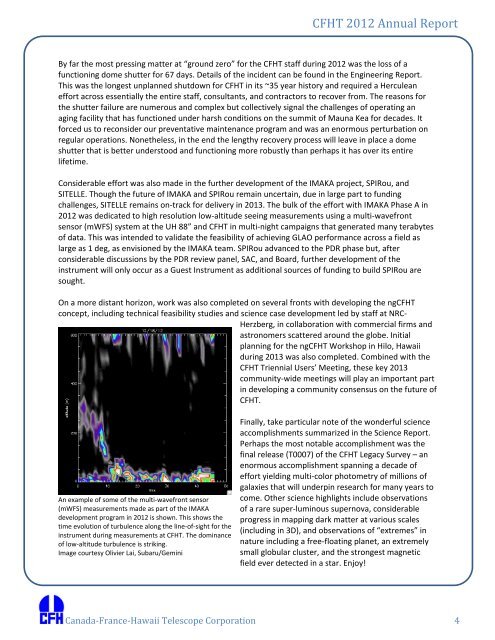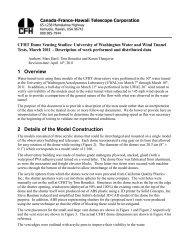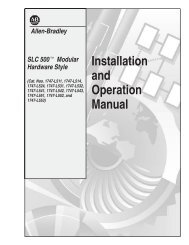2012 CFHT Annual Report - Canada France Hawaii Telescope ...
2012 CFHT Annual Report - Canada France Hawaii Telescope ...
2012 CFHT Annual Report - Canada France Hawaii Telescope ...
You also want an ePaper? Increase the reach of your titles
YUMPU automatically turns print PDFs into web optimized ePapers that Google loves.
<strong>CFHT</strong> <strong>2012</strong> <strong>Annual</strong> <strong>Report</strong><br />
By far the most pressing matter at “ground zero” for the <strong>CFHT</strong> staff during <strong>2012</strong> was the loss of a<br />
functioning dome shutter for 67 days. Details of the incident can be found in the Engineering <strong>Report</strong>.<br />
This was the longest unplanned shutdown for <strong>CFHT</strong> in its ~35 year history and required a Herculean<br />
effort across essentially the entire staff, consultants, and contractors to recover from. The reasons for<br />
the shutter failure are numerous and complex but collectively signal the challenges of operating an<br />
aging facility that has functioned under harsh conditions on the summit of Mauna Kea for decades. It<br />
forced us to reconsider our preventative maintenance program and was an enormous perturbation on<br />
regular operations. Nonetheless, in the end the lengthy recovery process will leave in place a dome<br />
shutter that is better understood and functioning more robustly than perhaps it has over its entire<br />
lifetime.<br />
Considerable effort was also made in the further development of the IMAKA project, SPIRou, and<br />
SITELLE. Though the future of IMAKA and SPIRou remain uncertain, due in large part to funding<br />
challenges, SITELLE remains on‐track for delivery in 2013. The bulk of the effort with IMAKA Phase A in<br />
<strong>2012</strong> was dedicated to high resolution low‐altitude seeing measurements using a multi‐wavefront<br />
sensor (mWFS) system at the UH 88” and <strong>CFHT</strong> in multi‐night campaigns that generated many terabytes<br />
of data. This was intended to validate the feasibility of achieving GLAO performance across a field as<br />
large as 1 deg, as envisioned by the IMAKA team. SPIRou advanced to the PDR phase but, after<br />
considerable discussions by the PDR review panel, SAC, and Board, further development of the<br />
instrument will only occur as a Guest Instrument as additional sources of funding to build SPIRou are<br />
sought.<br />
On a more distant horizon, work was also completed on several fronts with developing the ng<strong>CFHT</strong><br />
concept, including technical feasibility studies and science case development led by staff at NRC‐<br />
Herzberg, in collaboration with commercial firms and<br />
astronomers scattered around the globe. Initial<br />
planning for the ng<strong>CFHT</strong> Workshop in Hilo, <strong>Hawaii</strong><br />
during 2013 was also completed. Combined with the<br />
<strong>CFHT</strong> Triennial Users’ Meeting, these key 2013<br />
community‐wide meetings will play an important part<br />
in developing a community consensus on the future of<br />
<strong>CFHT</strong>.<br />
An example of some of the multi‐wavefront sensor<br />
(mWFS) measurements made as part of the IMAKA<br />
development program in <strong>2012</strong> is shown. This shows the<br />
time evolution of turbulence along the line‐of‐sight for the<br />
instrument during measurements at <strong>CFHT</strong>. The dominance<br />
of low‐altitude turbulence is striking.<br />
Image courtesy Olivier Lai, Subaru/Gemini<br />
Finally, take particular note of the wonderful science<br />
accomplishments summarized in the Science <strong>Report</strong>.<br />
Perhaps the most notable accomplishment was the<br />
final release (T0007) of the <strong>CFHT</strong> Legacy Survey – an<br />
enormous accomplishment spanning a decade of<br />
effort yielding multi‐color photometry of millions of<br />
galaxies that will underpin research for many years to<br />
come. Other science highlights include observations<br />
of a rare super‐luminous supernova, considerable<br />
progress in mapping dark matter at various scales<br />
(including in 3D), and observations of “extremes” in<br />
nature including a free‐floating planet, an extremely<br />
small globular cluster, and the strongest magnetic<br />
field ever detected in a star. Enjoy!<br />
<strong>Canada</strong>‐<strong>France</strong>‐<strong>Hawaii</strong> <strong>Telescope</strong> Corporation 4




![Documentation [PDF] - Canada France Hawaii Telescope ...](https://img.yumpu.com/26965302/1/190x245/documentation-pdf-canada-france-hawaii-telescope-.jpg?quality=85)







